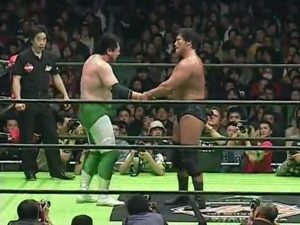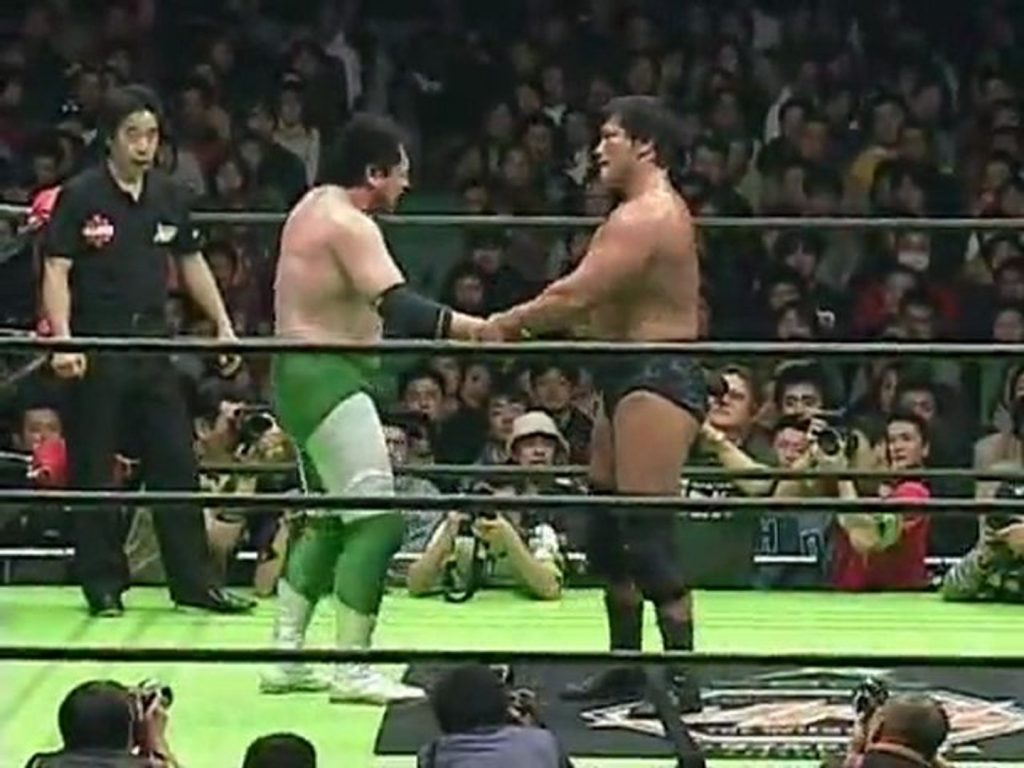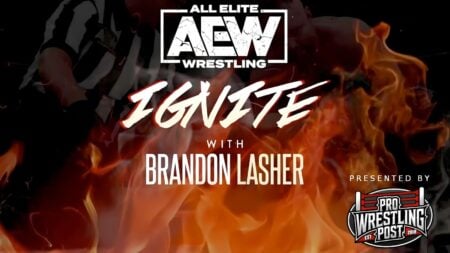On March 1st 2003, Misawa and Kobashi faced each other for the final time. Many wrestling fans call this the best match of all time. It’s widely regarded as one of if not the best match of the 21st century.
Plenty of fans have put it up there in the same conversation as the now-fabled Okada vs. Omega match from January 4th, 2017. Today, we look at the final major singles match between Japanese wrestling legends Mitsuharu Misawa and Kenta Kobashi.
Misawa and Kobashi | An extensive backstory
Going into this match, Misawa & Kobashi had an extensive history together. They were teammates from 1990 to 1996 and then intense professional rivals from 1997 up to this match.
Throughout the 1990s, Misawa was All Japan Pro-Wrestling (AJPW)’s unquestioned ace and one of the best wrestlers to ever live.
And during that same period, Kobashi went from a rookie to an established top guy, and he has likewise been called one of the best wrestlers of all time. Yet for Kobashi, there was one feat he couldn’t accomplish: defeat Misawa decisively.
From 1989 to 2001, Misawa and Kobashi faced each other fifteen times, and Misawa won all but one of those matches. Kobashi’s sole win came in the 1994 Champion Carnival tournament.
But that win was widely seen as a fluke. Kobashi just couldn’t beat Misawa and surpass him. He came close many, many times but came up short, especially in championship challenges.
Then came the 21st century and a litany of changes. Misawa left AJPW to form Pro Wrestling NOAH, and Kobashi followed him. Misawa’s plan was to make Kobashi into NOAH’s top star for the time being until they could crown a new, younger ace.
But there were problems with this. Kobashi’s body was in awful shape after being an overachiever in AJPW for a decade. His knees were absolutely thrashed from him spending years doing moonsaults and using them for his big power moves.
Kobashi desperately needed surgery and ended up spending over a year rehabbing his knees. He returned in 2002, but it still wasn’t until 2003 that he was 100% ready for a big match.
Furthermore, Misawa wasn’t in that good shape either. Years of wrestling in the high-intensity and high-risk King’s Road wrestling style had taken their toll on him. Misawa had taken MANY dangerous bumps over the years, often on his head and neck.
He wrestled in twenty, thirty, and forty-minute matches on a regular basis and kept going night after night. Imagine Misawa’s wrestling schedule like Ric Flairs when Flair was wrestling seven days a week throughout the 1970s and 1980s.
Then add onto that the highly stiff and intensive Japanese wrestling style. You can imagine what shape Misawa was in in 2003.
And yet, the stars aligned for these two longtime rivals to have one last match together. It was even announced as such.
That no matter how the business changed for NOAH, Misawa and Kobashi would never have a singles program with each other ever again after this match.
Needless to say, the hype was real. Misawa and Kobashi had many of the best matches of all time together, and this match would be the final chapter. But both of them were seen as being WAY past their respective primes.
Could they live up to the insanely high standards they themselves set during their peak years in All Japan?

Act I
The match begins as all Misawa and Kobashi matches do: with a tense technical exchange that leads to a standoff. Both men look for early openings or advantages, and Misawa finds one by getting in an early armlock.
That’s done with an important purpose: to weaken Kobashi’s lariat arm, making that main finisher of his less likely to lead to a win later on. Misawa spends several minutes working this arm, only for Kobashi to power out of Misawa’s control.
Except Misawa always had a clever way of escaping his opponent’s control, which he did here as well. After landing a sudden elbow strike, a flustered Kobashi charges into Misawa, only to run into the first of many head-drops in the form of a Backdrop suplex.
Misawa remains in control by neutralizing Kobahsi’s arm. Kobashi keeps fighting back (because his gimmick is that he’s like a runaway freight train that keeps going no matter how much pain he’s in), and Misawa shuts him down with one elbow smash after another.
This goes on for a bit until Misawa gets too cocky and skins the cat and dives towards Kobashi, but Kobashi sidesteps, and Misawa goes face-first into the steel barricade. And he hits it HARD. Hard enough for blood to pour from his chin.
Act II
Sensing an opportunity, Kobashi begins his task of weakening Misawa’s neck for one of his finishers. At this point in time, Kobashi has basically had to completely rethink his wrestling style since jumping and diving are out of the question due to the condition of his knees.
Thus, he has to rely on three main moves: the lariat, the brainbuster, and the Burning Hammer. The latter, of course, is his super-finisher, his ultimate weapon that, at the time of this match, he had only used three times before.
But to make sure Kobashi’s neck-targeting strategy works, he must first dump Misawa on his head. Which he does, plenty of times. Neck locks, Half-Nelson suplexes, leg drops, full nelsons, DDTs, and of course, countless stiff chops to the neck are all dished out.
But Misawa just won’t go down. No matter what Kobashi dishes out, Misawa keeps coming back. At one point, Misawa even starts hulking up King’s Road style, eating stuff, kicks, and chops and just no-selling them, much to the crowd’s delight.
Misawa begins a comeback of sorts with stiff elbow strikes, which in the past had been enough to keep Kobashi down for the three-count. But not now. So now Misawa has to turn the tables on Kobashi and give him a taste of his own medicine.
This comes in the form of Tiger Suplexes, face locks, elbows to the face and neck, Tiger Drivers, and a rare Tiger Suplex ’85. But Kobashi, like his former partner and mentor, refuses to stay down.
Act III
Kobashi gets his own second wind by countering Misawa and landing another Half-Nelson suplex. The two gladiators fight like hell until Misawa lands on the apron off a suplex and suplexes Kobashi over the top rope and onto the hard entrance ramp.
Then, sensing that he really has to go all out to keep Kobashi down, Misawa does something incredible: he lands a Tiger Suplex from the entrance ramp to the floor. Kobashi takes a horrifying bump from a good five feet off the ground, plus the arc of the suplex, and lands on his neck and shoulders.
1st March 2003 ~ the 18th anniversary of one of the sickest bumps in all of pro wrestling. #noah_ghc pic.twitter.com/JGn4MBYrd4
— Noah’s Arkive ⚓️ (@Hi5ame) February 28, 2021
And yet, Kobashi somehow gets back into the ring at the count of nineteen (out of a possible twenty).
Even after all that damage, Kobashi remains defiant. Thus, Misawa is left with no choice: he must put Kobashi down with his newest super-weapon, the Emerald Flowsion (a side Tombstone Driver).
Misawa hoists him up. And then plants him. The match is over. Except it’s not. Kobashi kicks out. Somehow, Kobashi musters enough strength to kick out of Misawa’s Emerald Flowsion. No one had ever kicked out of that move before. The reaction in Budokan Hall is absolutely thunderous.
At this point, Misawa has but one trick still up his sleeve: the Tiger Driver ’91. The ultra-dangerous, head-spiking version of the Tiger Driver that had put down many opponents in the past, including Kobashi.
But Kobashi was also the only person to kick out of the TD’91 as well. But surely he couldn’t do so now after so much damage, could he? Well, we’ll never know because Kobashi powers out of Misawa’s control and lands a desperation lariat.
Kobashi’s weakened arm connects with Misawa’s weakened neck. But it’s not enough to keep Misawa down. So Kobashi resorts to a sheerdrop Brainbuster. It’s still not enough. There’s only one course of action left. Torture Rack. Burning Hammer! Kobashi pins Misawa.

Misawa and Kobashi | Legacy
If there’s one word that can be used to describe this match, it’s ‘unpredictable.’ Even though these two men have faced each other many times, no two of their matches look identical.
And once again, they managed to create a unique story here that both created new twists and turns while logically calling back to their previous wars together.
Every time Misawa and Kobashi were face to face or one behind the other, it was impossible to predict what would happen. Would one block the other? Would a big suplex land? And if it did, would the victim no-sell it and charge with their own big move or slump down in exhaustion?
There was just no way of telling with these two, even as they layered so many key moves, one on top of the other in a logical, seamless way.
In the end, both men left this match looking less like ordinary wrestlers and more like gods. They had beaten each other so badly, but both still kept going. They risk their lives for championship glory and to give the fans a match for the ages.
And even though both men were way past their primes, they more than delivered in this match.
And for Kobashi, it was the perfect way to end his storied rivalry with Misawa. Yes, Misawa had won more matches. But Kobashi always left those matches looking better than when he went in.
And here, he not only beat Misawa, he surpassed Misawa. He became the ace of NOAH and began what is widely considered the best heavyweight championship reign of the past thirty years.
What this match may lack in speed and ‘athleticism,’ it makes up with airtight psychology, amazing storytelling, brutal offense, and incredible drama.
It’s the pro-wrestling equivalent of a gladiatorial fight to the death. Except that in this fight, both men fight so well that both their lives are spared out of sheer respect.








1 Comment
Excellent article as always Alex. Every time I see an article pertaining to Japanese wrestling, and see you’ve written it, I know it’s going to be a fantastic read! Love your work buddy!